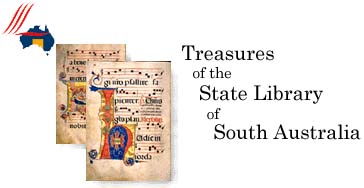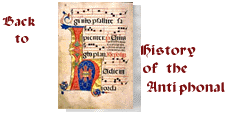
 |
|

The Antiphonal contains the text and music for the sung responses
proper to Christian church services for the church year from Christmas
Eve to the end of the Feast of the Epiphany, as they were celebrated
in a central Italian monastery in the 13th century. It begins
with the first vespers for Christmas, on Christmas Eve, and finishes
on the last day of the octave, or eight-day feast, of the Epiphany,
on January 13th. Important divisions in the text are marked by
one historiated and thirteen illuminated initial letters.
By the 13th century, the calendar for the Christian church year
was divided into two simultaneous cycles, the Temporal, celebrating
the life of Christ, and the Sanctoral, celebrating the feast days
of saints. These two calendars determined what were the appropriate
services for each day. The patron saint of a particular order,
monastery, church, or geographical area is given special prominence
in appropriate services. Our Antiphonal is described as temporal,
because the text focuses on the birth of Christ and the subsequent
days, but there are saints' days occurring during this period
and the services for these days are part of the text.
The services were at set hours of the day and night, and each
had its own name: Matins, Lauds, Prime, Terce, Sext, None, Vespers
and Compline.The verses and responses in antiphoners were for
all services apart from the Mass. Instructions for these services
are to be found in red throughout the text, in very abbreviated
Latin which is difficult for a later reader. Arriving at their
meaning is more like cracking a code than translating from Latin.
The order of service used with an Antiphoner is called a Breviary.
The psalms were sometimes contained separately in a Psalter, and
the hymns in a Hymnal. The number of books available for use in
a service, and their contents, varied according to the resources
of the monastery, since the monks were creating by hand what they
needed.
The monastery from which our Antiphonal came may have owned comparable
antiphoners for the whole of the church year. If it did indeed
come from the monastery of Santo Stephano, it belonged to flourishing
community of some affluence. A manuscript index in a 16th century
hand at the end of the book alludes to the work as "Liber
Secundus", or Volume Two, suggesting that there was at least
one other.
The illuminated letter for Matins, the first morning service,
on Christmas Day, contains a representation of the birth of Christ.
It is the only initial which portrays a scene, as well as elaborate
decoration, and the purpose is to announce the central subject
of the whole text. In transcribing and translating the text it becomes very clear that it is as much part of an oral tradition as of a written one. The grammar is considerably removed from that of classical Latin, some of it reads very oddly in terms of its sense, and the scribal errors indicate that either the copyists' Latin was not of a high standard, or that they were copying automatically without thinking about what they were writing. |

Copyright and this website | Disclaimer | Privacy | Feedback | Accessibility | Freedom of Information | Last update on 20 December 1997
The URL for this page is http://www.slsa.sa.gov.au/treasures/antiphonal/text.htm